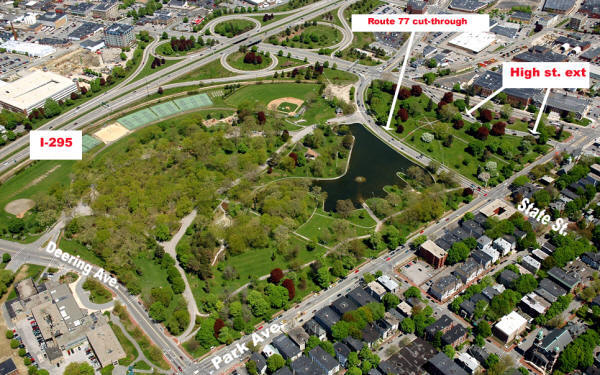Deering
Oaks
The Deering Oaks Reconstruction plan:
Plan S-2
"We want the congestion around the park. If it's congested, people won't want to drive there, and we don't want them driving through our neighborhood" : Steven Scharf, Secretary; Parkside Neighborhood Association, June 30, 2004,
King Middle School
This is a sordid little tale, years in the making. Ostensibly a plan to "improve" Portland's premier park, it was going to turn the park area into a parking lot; a congested, environmental nightmare, a shell of what it is today.
 |
| Deering Oaks, Portland, Maine |
A Common Disaster:
The Deering Oaks Reconstruction Plan
In 2000 the City of Portland was in the process of gathering information, support, and funding for development of a program to redesign roadway access to the Portland Peninsula. The City would be undergoing myriad changes in the next decade, what with the construction of the Ocean Gateway Project at the harbors edge at the bottom of Franklin Arterial, and the construction of four new 6 to7-story office buildings east of the Gateway. A 100-million dollar Westin Hotel was also slated for the site of the old Jordan Meats plant in that area.
A new 10,000 seat Civic Center Office Complex was under consideration at the top of the Peninsula two blocks away, on what is now a parking lot in front of the Franklin Towers.
Bayside, the area between Marginal Way and Congress St., and Franklin Street Arterial and Preble Street, is currently being developed, with much new construction already on hand, or in progress. A new Intermed office building, student housing for University of Southern Maine, Whole Foods Grocery, and others have been built or planned. The two scrap metal yards currently just off Marginal Way are being forced to relocate away from Portland.
As development usually brings with it more and varied types of traffic problems, the City contracted with engineering firms Gorrill-Palmer Associates, Wilbur-Smith Associates, and Kevin Hooper Associates to study the traffic situation in Portland with an eye towards then current problems, future problems, and how to solve those problems contingent with any planned development.
Prior to 2004 , Anne Pringle, former City Councilor and Mayor of Portland, now head of The Friends of Deering Oaks, had asked the City to do a traffic study of the Oaks in an effort to eliminate the Route 77 cut-through in the Park. She wanted this done to improve the Park experience, and to allegedly improve the Parkside neighborhood.
During the course of that study, the city realized that any changes to the park and Parkside neighborhood would affect traffic peninsula-wide, so a wider look was needed.
A Peninsula Traffic Study Committee was formed, comprised of neighborhood and business leaders, and politicians, along with officials and engineers from the Portland Planning Dept. and Greater Portland Council of Governments. The “neighborhood and business leaders” might be considered those with a very vested interest in getting just what they wanted to out of The Plan.
From Chapter 4 of Lewis Carroll’s
Through the Looking-Glass:
"I know what you're thinking about," said
Tweedledum; "but it isn't so, nohow.
"Contrariwise," continued Tweedledee, "if it was
so, it might be; and if it were so, it would be; but as it isn't, it ain't.."
The efforts of the Committee and engineering consultants led to the creation by Gorrill-Palmer Associates of the “Portland Peninsula Traffic Plan, a draft of which was presented to the City in January 2004. The study covers the entire Peninsula. Most, if not all, of the controversy within the study is contained within Chapter 9 : The manifestly illegal pollution-producing Deering Oaks Reconstruction Plan.
The Oaks Reconstruction Plan was nothing more than a land grab of a
public facility (the streets) by a group of
people who had a stated interest in reducing or eliminating people from
outside the neighborhood from traveling through the neighborhood.
It was an attempt to remove from use a major arterial
that runs through Parkside, Route 77.
This would be done by decreasing the Level of Service (how
well the intersections function) of all the intersections involved, to a
level where they would become undriveable. It was a very aggressive covert
attempt to divert traffic elsewhere, at huge governmental, public, and
environmental
expense.
MDOT and the FHWA had some severe reservations about all of this. State Traffic Engineer Steve Landry went looking for information, which can be seen here.
The Study Plan was the opening salvo of this "theft" from the public, scattershot as it was. Filled with sentences that contradicted themselves from one to the next, section after section, it provided the reader with a vaguely confusing, but generally comforting feeling about the project. It was a good idea, unless you knew what the agenda was, and could read between the lines. To start; look at the Preface.
The Friends of Deering Oaks seem to think of the Park
as their little fiefdom. Some years ago, when they got tired of hosting
the once-a-year Deering Oaks Festival in the park because of the noise
and crowds, they had the festival moved to the Maine Mall parking lot,
7 miles away.
The reason given was that too many people were compressing the
ground, which was bad for the trees. No trees at the Mall though, so
they were safe.
The Children’s Theater of Maine, one of the oldest amateur theater groups in the United States, used to hold plays in the park-- 4 performances over two weekends. This was a major production for the theater, the ticket revenues from which helped it to survive financially. Performances were stopped by the Friends because the plays were considered an “inappropriate use” of the park.
Next : Myth, Reality, and Methodology